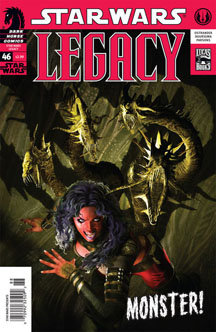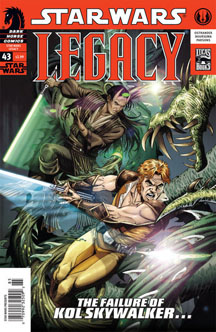A major impetus behind launching a series set four generations after Luke Skywalker was that it gave the writer freedom to chronicle a fresh part of the timeline. But by the time of “Legacy”Issues 41-47 (2009-10), a big appeal of John Ostrander’s saga is the way it ties back to the wider mythos.
Although “Legacy” could theoretically be enjoyed by someone who knows nothing about “Star Wars” in general, it gains more heft when we see the Sith Empire’s genocidal policy against the Mon Calamari, a species that has been on the side of freedom and liberty dating back to “The Clone Wars” TV series; when we see the latest batch of Rogue Squadron pilots in action; and when we recall the Yuuzhan Vong’s Embrace of Pain from “The New Jedi Order” saga. Even something as small as the mention of Dac’s aquatic whaladons, one of the few elements from “The Glove of Darth Vader” to catch on, shows that Ostrander approaches this material from a fan’s perspective.

As “Legacy” moves forward, it has also filled in the years preceding Issue 1. “Monster” (Issues 43-46) is the best example so far, as we see Darth Maladi – with help from twisted Yuuzhan Vong shaper Zenoc Quah — is the one who sabotaged the Kol Skywalker/Yuuzhan Vong mission to renew planets such as Wayland that had been ravaged way back in the “New Jedi Order” saga.
While this is far from a complete picture of the time between the lives of Ben Skywalker and his great-grandson, Cade, it’s enough. We know that three generations of Darth Wyyrloks were keeping Darth Krayt in stasis during this period, and I like to think that there were no major galactic villains actively threatening Luke, Leia and Han in the third act of their lives, after the events of the novel “Crucible.” They deserve at least that much peace.
Speaking of Darth Krayt, Wyyrlok and Cade (who both played a part in Krayt’s death back in Issue 26) are confident the Sith lord is dead, and Wyyrlok has placed Krayt’s corpse in a Korriban stasis chamber so that he may rule in his stead. At the end of “The Fate of Dac” (47), however, only Krayt’s armor is in the chamber, setting forward a nice mystery as “Legacy” enters its final stretch. Did Darth Talon steal the body? Or was it Wyyrlok’s daughter? Or is Krayt somehow alive?
In “Monster,” Cade overcomes the pull of the Sith and saves Deliah Blue from the Embrace of Pain using the light side of the Force. Stories about Force-users succumbing to the dark side have become far too common, so it’s nice to see that Cade is a different kind of hero – not Jedi, not Sith, just a Force-user with a good heart. The page showing flashbacks of Cade’s relationship with Blue is powerful.

Ostrander has always peppered smaller character pieces into Cade’s saga, and in this batch we get two more. “Rogue’s End” (41) brings Mandalorians into “Legacy” for the first time via the backstory of Hondo Karr, a Mando who posed as an Imperial by necessity (thus shedding new light on “Noob,” Issue 4, when we met Karr as a stormtrooper) and later joined Rogue Squadron.
“Divided Loyalties” (42) chronicles one of the most disturbing ways the evil Sith Empire manipulates its citizens’ behavior: via threats to loved ones. Mon Cal Ranger shipman Tealart attempts to assassinate Galactic Alliance Admiral Gar Stazi, hoping to parlay the act into a deal for his family’s safety. “You are forgiven, but not excused,” says Stazi, who adds that Tealart will be “court-martialed, found guilty and executed” by the G.A. military.
A couple posts ago, I guessed that the Sith Empire overplayed its hand with its policy of genocide, and we start to see the backlash from the galaxy at large in “The Fall of Dac.” Good Samaritans from all over, including Cade’s uncle Bantha, haul citizens away from Dac in the face of a plague unleashed by Sith scientist Vul Isen (a great use of the “Scream”-mask-faced Givin species). We’re primarily following the superpowered and military heroes – from Cade to Hondo Karr – in “Legacy,” but as history teaches us, it’s ultimately the citizenry at large that says “no more” to an oppressive regime.

